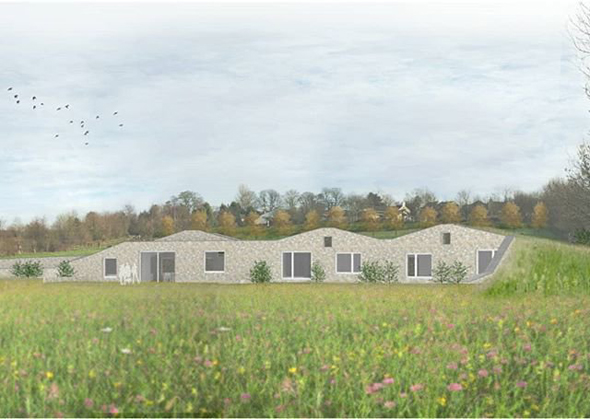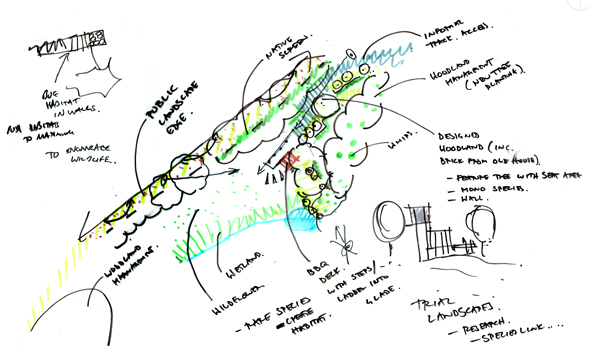Since we achieved planning for The Burrows, one of the earliest approvals under National Planning Policy Framework NPPF Paragraph 79 (formerly NPPF55 or Paragraph 55), we have been asked by a number of clients to build them a home in the countryside – and overcome the planning challenges that undoubtedly follow.
New houses in the open countryside are described in planning terms as “inappropriate development”. Paragraph 79 states that planning consent may be granted if the proposals represent ‘exceptional quality or innovative nature of the design’. The intent is for schemes to demonstrate extra special circumstances that outweigh any harm to the open countryside.
Since 1997, the policy opened up opportunities for ambitious individuals to build mansions of distinction provided they were ‘of the highest quality, outstanding in terms of its design and innovation, would significantly enhance its immediate setting and be sensitive to its wider surroundings’.
Who wouldn’t want to build a stunning home in the countryside?
We’re often approached by clients who see building in the countryside, on an otherwise worthless piece of land, as their only way to build a home. Many just can’t afford land already earmarked for housing – planning permission in place can increase the value tenfold. But it’s not the cheap route they expect so many clients are unable or unwilling to take the required risk.
What do you need to give you the best chance of success?
Exceptional site
Not all countryside land can support an exceptional home. The site itself needs to have something about it that is regarded as exceptional or individual. A strong story is key for the genesis of any project, especially as local authorities are keen to ensure any potential approval is seen as a ‘one-off’ and doesn’t set a precedent for similar projects on similar sites.
Exceptional design
Most hold the view that beauty (or great design) is subjective. However, quality of design is in fact objective, measurable and not at all subjective. For an architect, going after ‘exceptional design’ is a treat – we get to flex our creativity and innovation – but one that isn’t taken lightly, or in isolation.
The difficulty of demonstrating design of the highest calibre will require the use of a Design Review Panel. This will need to be from an early design stage with consultation continuing throughout the planning process. Even with this expert input, there is no guarantee the local authority will have a positive response to a scheme. They would often prefer to have it tested at appeal.

Innovative design
Innovation is another tricky word of the clause to define and interpret, but (usually!) easier to demonstrate. Whether the design is unique, or something that has been done before but not in such an application, many new schemes are gaining planning after starting from an unorthodox position to housebuilding. The issue with innovation though is its very nature. What we specify today as unique may be the standard when the scheme completes in a few years:
Sustainability
- We saw Passivhaus as innovative back in 2012 when we achieved planning for The Burrows, but most recent Paragraph 79 homes have Passivhaus as a benchmark.
Mechanical and Electrical systems
- The latest gadgets you can specify might be untested (at worst) and seen as overtly ‘green washing’ at best.
Biodiversity
- The landscape design is also very important and must be a holistic approach to the surrounding landscape.
Our approach to NPPF Paragraph 79 homes
We start with the site in its landscape/context. We undertake an initial design workshop with a landscape architect to develop a design approach that is more about landscape than buildings. This allows the building design to become much more site-specific.
It also helps us to test early on, before the client has invested too much into the project, whether the site really can support a new home under this policy. Plots with a distinctive character or narrative are more likely to be successful. Site-specific design is key, as is client specific design.

“The house should never be considered outside its regional and local context. Site-specific design is key. As is client specific design.”
The process from this point onwards is collaborative. Between us and you, the client, but also with a team of landscape architects, structural specialists and planning consultants.
We would consider Passivhaus as a baseline for the build. It’s the gold standard not only in terms of the efficient building fabric but also of delivering it. Despite this, it’s unlikely something we’d try and hang an innovation argument from. The nature of Paragraph 79 encourages inventive moves in all aspects of the scheme.

What else do you need to consider?
Costs
With exceptional and innovative design a requirement, design and build costs are not going to be cheap. While The Burrows was 180m2, most schemes may be significantly larger, with a build cost reflecting this. Exceptional sites often have inherent constraints such as a slope or poor access which will likely impact on costs. Paragraph 79 homes don’t have to be large projects though. We strongly believe that innovation and exemplary design shouldn’t exclude more modestly scaled homes.
Design Fees
The design process is likely to involve a team of consultants (landscape, planning, sustainability, etc), and Design Review Panels at a number of stages. You will also require lots of specialist surveys and reports up front with no promise of anything better than 50/50 odds for approval. The design process for a home like this will also be very time consuming and, again, fees will reflect this. It’s a considerable undertaking with risk and costs before construction starts could be in the region of £30-100K. It’s clear to see why large, expensive homes are the norm.
Risk
We try to minimise this risk by working in clear, defined stages. Even the early workshop output is a moment to reflect – a line in the sand. Design Review is another clear moment. As is the pre-application response from the local authority.
NPPF paragraph 79 isn’t the only planning constraint. Highways, visual impact, protected species, trees etc. are also critical. It’s important to set aside everything but the ultimate principle/design of the dwelling. We aim to avoid a refusal based on technical issues rather than the matter of exceptional design.
Ready to begin your Paragraph 79 journey?
We have plenty of experience designing and achieving planning success for Paragraph 79 homes. We can guide you through the process and help you to assemble the best possible team for the project.
